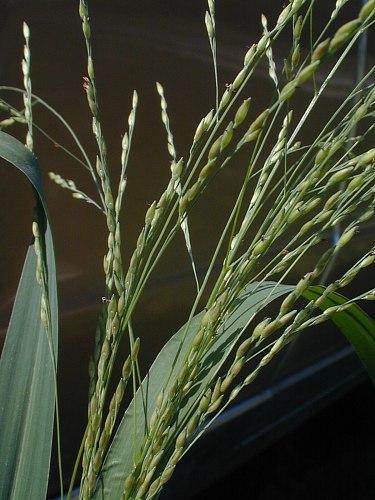Annual or short-lived perennial herb, tufted 5 cm - 2 m tall
Leaves: alternate, two-ranked. Sheaths compressed, inflated, sometimes sparsely hairy. Ligules 0.5 - 2 mm long, membranous, fringed with hairs. Blades 10 cm - 0.6 m long, 3 mm - 2.5 cm wide, lance-shaped, parallel-veined, sometimes sparsely soft-hairy, with stout, whitish midribs.
Inflorescence: a branched arrangement of spikelets (panicle), lax, diffuse, 4 - 40 cm long, with stiff, solitary branches and a few spikelets. Branches alternate or opposite, sometimes appearing whorled, spreading to ascending, to 15 cm long, rough. Spikelet stalks appressed mainly to one side of the branch, 1 - 6 mm long, sharply three-angled, rough.
Fruit: a caryopsis, indehiscent, enclosed within the persistent lemma and palea.
Culm: upright to decumbent, often knee-like to ascending, unbranched to widely branched, green to purplish, 5 cm - 2 m long, 0.5 - 3 mm wide, slightly compressed, often succulent, shiny, lower nodes rooting when in water. Nodes often swollen.
Spikelets: light green to reddish purple, 2 - 4 mm long, 0.5 - 1 mm wide, ellipsoid to narrowly egg-shaped with a pointed apex.
Glumes: unequal, herbaceous. Lower glumes clasping, 0.5 - 1 mm long, one-fourth to one-third as long as spikelets, blunt to pointed at the apex, zero- to three-veined. Upper glumes similar to lower lemmas, exceeding upper florets by about 0.5 mm, seven- to nine-veined.
Lemmas:: Lower lemmas similar to upper glumes, exceeding upper florets by about 0.5 mm, seven- to nine-veined, keeled. Upper lemmas shiny, with rolled-up margins on the upper surface.
Paleas:: Lower paleas rudimentary to nearly as long as lower lemmas, transparent. Upper paleas longitudinally lined.
Florets:: Lower florets sterile. Upper florets bisexual, straw-colored to blackish, 1.5 - 2.5 mm long, about 1 mm wide, narrowly ellipsoid with a pointed apex, shiny, pale-veined. Anthers three. Stigmas red.
Similar species: No information at this time.
Flowering: mid-August to late October
Habitat and ecology: One of the most common grasses in the Chicago Region, often growing in disturbed areas such as cultivated fields, ditches, and roadsides.
Occurence in the Chicago region: native
Etymology: Panicum comes from the Latin word panis, meaning bread, or panus, meaning "ear of millet." Dichotomiflorum means "with a forking inflorescence."
Author: The Morton Arboretum
Glabrous annual to 1 m or more, erect to decumbent or diffuse; panicle in large plants to 4 dm, widely branched; lf-blades 4-20 mm wide; spikelets 1.6-3.3 mm, green or purple-tinged, ellipsoid to oblong; first glume broad, obtuse or rounded, a third as long; second glume and sterile lemma acute, 7-veined, the latter with or without a palea; 2n=36, 54. Moist soil and shores, often a weed in cult. land; N.S. and Que. to Minn. and S.D., s. to Fla. and Tex.
Gleason, Henry A. & Cronquist, Arthur J. 1991. Manual of vascular plants of northeastern United States and adjacent Canada. lxxv + 910 pp.
©The New York Botanical Garden. All rights reserved. Used by permission.
My only specimen of this variety is from a dried-up pond about 3 miles southwest of Tefft, Jasper County, where it was closely associated with Panicum spretum. The specimen I reported from Kosciusko County I am now referring to Panicum Gattingeri Nash.








